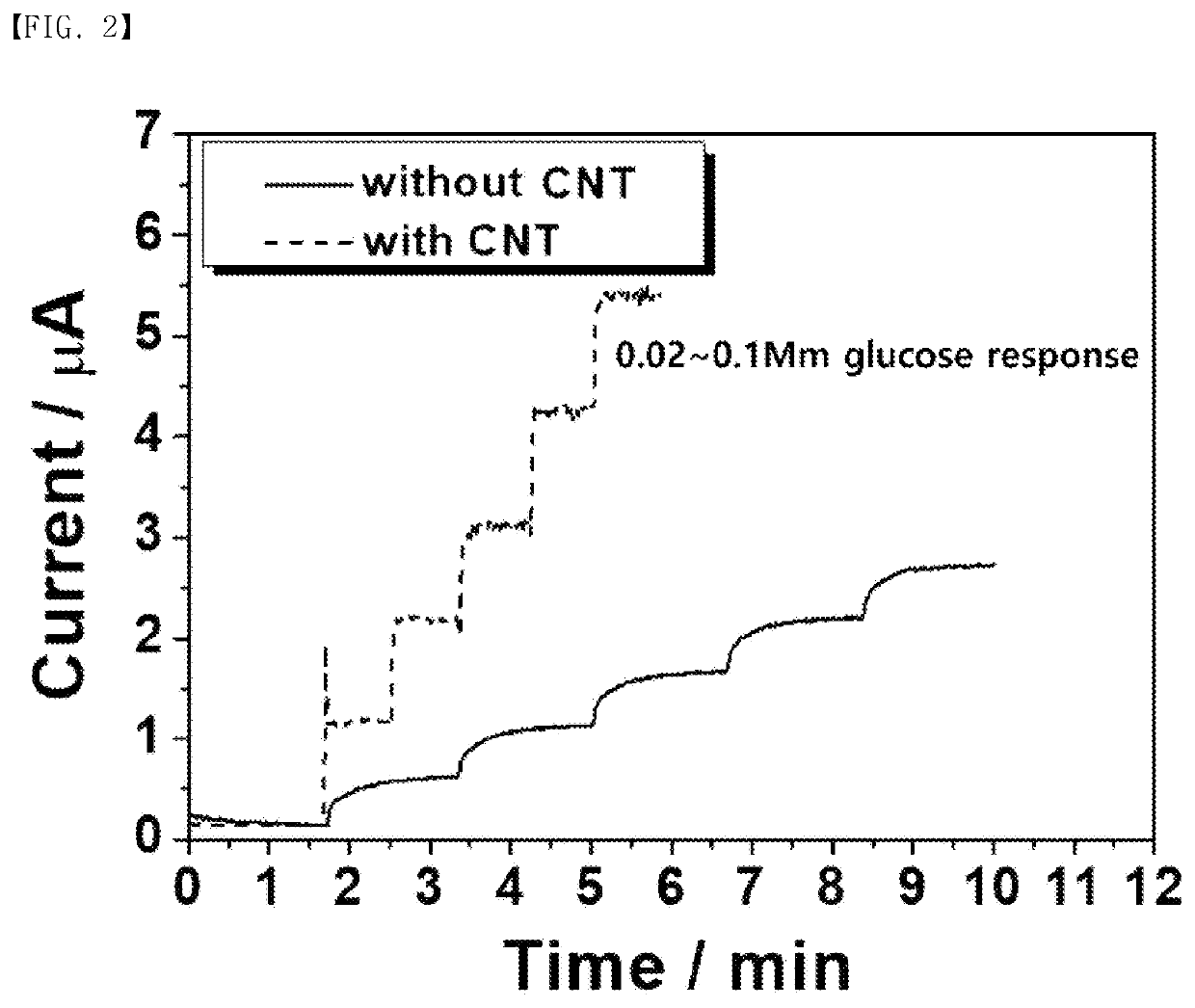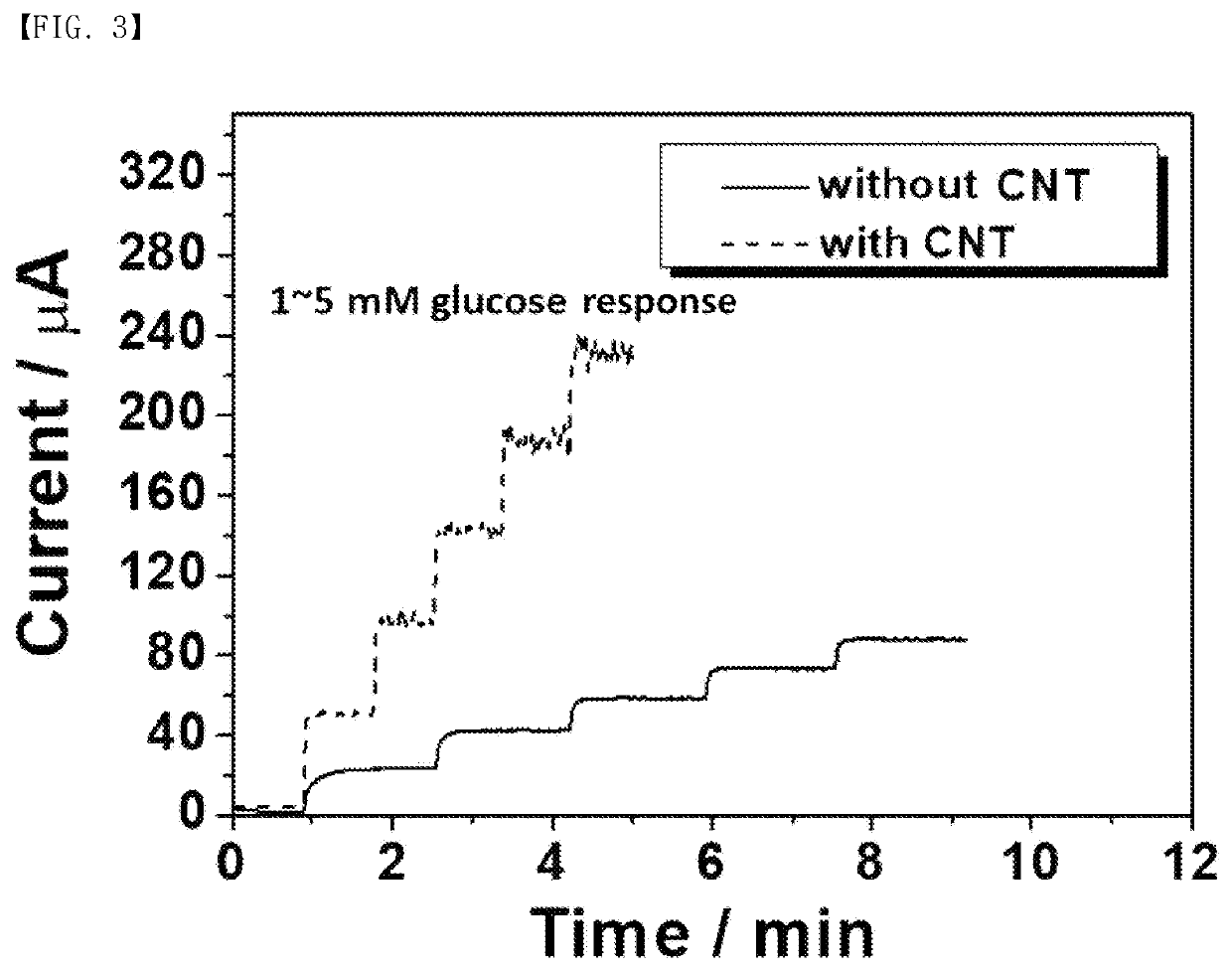Electrochemical biosensor comprising carbon nanotube for measuring biosignals and method for manufacturing same
a biosignal and carbon nanotube technology, applied in the field of biosignal measurement electrochemical biosensors, can solve the problems of pain in the measurement of blood sugar level, inability to observe the change in blood sugar level of patients, and the very time of smbg technology, which can be a great burden for young diabetics, etc., to achieve rapid and accurate measurement of changes, increase adsorption force, stability and electron transfer rate, the effect of increasing the reaction rate and accuracy
- Summary
- Abstract
- Description
- Claims
- Application Information
AI Technical Summary
Benefits of technology
Problems solved by technology
Method used
Image
Examples
example 1
n of Cyclic Voltammetry of Electrochemical Sensor for Continuous Blood Sugar Measurement with or without Carbon Nanotube
[0061]As a method for comparing the electron transfer performance of the electrode comprising a carbon nanotube with the electrode without a carbon nanotube, cyclic voltammetry was used. As a reference electrode for cyclic voltammetry, Ag / AgCl electrode was used. As a counter electrode, a platinum wire was used. As an electrolyte used when conducting cyclic voltammetry, physiological saline solution comprising phosphate buffer was used. When conducting cyclic voltammetry, as the scan rate converting the applied voltage, 10 mV / s was used. The order of applying voltage was first scan from high voltage to low voltage. This experimental result was shown in FIG. 1. As could be confirmed in FIG. 1, it could be found that the electrode comprising a carbon nanotube showed a higher redox peak than the electrode without it.
Example 2: Comparison of Responsivity to Low Concent...
example 3
n of Responsivity in High Concentration Glucose of Electrochemical Sensor for Continuous Blood Sugar Measurement with or without Carbon Nanotube
[0063]In order to compare the responsivity according to the presence or absence of the electrochemical sensor for continuous blood sugar measurement with or without a carbon nanotube in a high concentration glucose, proceeding by the same method as Example 2, it was tested using the concentration of glucose of 1 mM, 2 mM, 3 mM, 4 mM and 5 mM and the result was shown in FIG. 3. As could be confirmed in FIG. 3, it could be found that the electrode comprising a carbon nanotube showed the responsivity about 2.5 times higher than the electrode without it. In addition, it could be found that the electrode without a carbon nanotube was saturated in the high concentration region and thus the responsivity was reduced, but in the electrode comprising a carbon nanotube, the current was linearly increased in proportion to the glucose concentration.
example 4
n of Maximum Current Arrival Time of Electrochemical Sensor for Continuous Blood Sugar Measurement with or without Carbon Nanotube
[0064]As a method for comparing the maximum current arrival time of the electrode comprising a carbon nanotube with the maximum current arrival time of the electrode without a carbon nanotube, chronoamperometry was used. Then, the reference electrode, counter electrode, applied voltage and electrolyte were performed in the same manner as Examples 2 and 3. When measuring the time of reaching the maximum current, the glucose solution at a concentration of 1M was added and finally, the glucose concentration was changed from 0.1 mM concentration to 1 mM, and the time for the current to reach the maximum when the concentration was changed was confirmed. Then, it was considered that the maximum current was reached when the noise occurred within the range of ±10% of the increased current, and the result was shown in FIG. 4. As could be found in FIG. 4, it could ...
PUM
| Property | Measurement | Unit |
|---|---|---|
| current | aaaaa | aaaaa |
| current | aaaaa | aaaaa |
| oxidation voltage | aaaaa | aaaaa |
Abstract
Description
Claims
Application Information
 Login to View More
Login to View More - R&D
- Intellectual Property
- Life Sciences
- Materials
- Tech Scout
- Unparalleled Data Quality
- Higher Quality Content
- 60% Fewer Hallucinations
Browse by: Latest US Patents, China's latest patents, Technical Efficacy Thesaurus, Application Domain, Technology Topic, Popular Technical Reports.
© 2025 PatSnap. All rights reserved.Legal|Privacy policy|Modern Slavery Act Transparency Statement|Sitemap|About US| Contact US: help@patsnap.com



